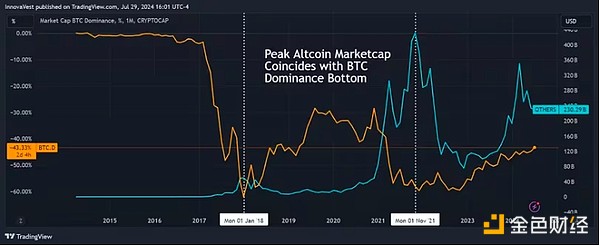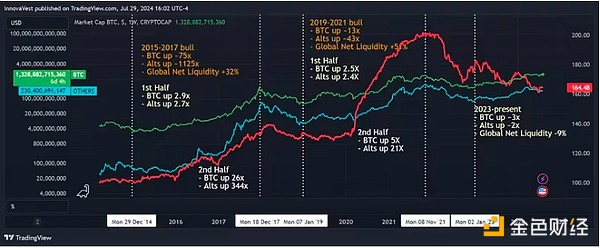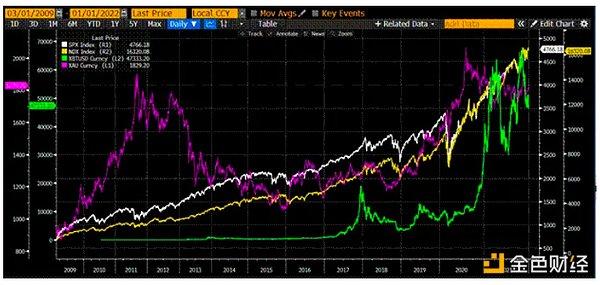Author: Kelly Ye, head of research at Decentral Park Capital, CoinDesk; Translated by Tao Zhu, Jinse Finance
Despite the short history of cryptocurrencies, with Bitcoin only turning 15 this year, we have already gone through three major cycles: 2011-2013, 2015-2017, and 2019-2021. The short cycles are not surprising, given that the crypto markets trade 24/7 and have roughly five times the volume of the stock market. The 2011-2013 cycle was primarily centered around BTC, as ETH was launched in 2015. Analyzing the past two cycles reveals some patterns that help us understand the structure of crypto bull markets. History could repeat itself once again as the market heats up ahead of the U.S. election and the outlook for liquidity improves.
BTC leads Altcoin into a rebound
In both the 2015-2017 and 2019-2021 cycles, Bitcoin initially led the market higher, building confidence and setting the stage for a broader rally. As investor optimism grew, capital flowed into Altcoin, driving the broad market rally. Altcoin market cap peaks often coincide with BTC market cap dominance bottoms, indicating a rotation of capital from BTC to Altcoin. Currently, BTC dominance is still climbing from its post-FTX lows, suggesting that BTC still has more room to run before Altcoin catch up.

Altcoin outperform in the second half of the cycle
In both major cycles, Altcoin have significantly outperformed Bitcoin after an initial phase where returns were comparable between the two. This trend reflects increased risk appetite among investors and the adaptability of the Altcoin market in the face of increased risk capital. In the second half of the 2015-2017 cycle, Altcoin returned 344x, while BTC returned 26x. Similarly, in the second half of the 2019-2021 cycle, Altcoin returned 16x, while BTC returned 5x. Following FTX, we are about halfway through the current cycle, with Altcoin slightly lagging behind BTC. This trend suggests that Altcoin may outperform in the second half.

Macroeconomic impact
Cryptocurrencies, like other risk assets, are highly correlated to global net liquidity conditions. Global net liquidity has increased by 30-50% over the past two cycles. The recent Q2 sell-off was partly driven by tighter liquidity. However, the trajectory of the Fed's rate cuts looks favorable as Q2 data confirms slower inflation and growth.
The market now expects a rate cut in September to be more than 95%, up from 50% at the beginning of the third quarter. In addition, crypto policy is becoming central to the US election, with Trump supporting crypto, which could influence the new Democratic candidate. The past two cycles have also overlapped with the US election and the BTC halving event, increasing the potential for a rally.
Will it be different this time?
While history won’t repeat itself exactly, the rhythmic nature of past cycles — initial Bitcoin dominance, subsequent Altcoin outperformance, and macroeconomic influences — set the stage for Altcoin rallies. However, this time may be different. On the positive side, BTC and ETH have entered the mainstream market through ETFs, and inflows from retail and institutional investors have hit record highs.
On the cautious side , a greater number and variety of Altcoin are competing for investor capital, and many new projects have limited circulating supply due to airdrops, leading to future dilution. Only ecosystems with solid technology and the ability to attract builders and users will thrive in this cycle.






